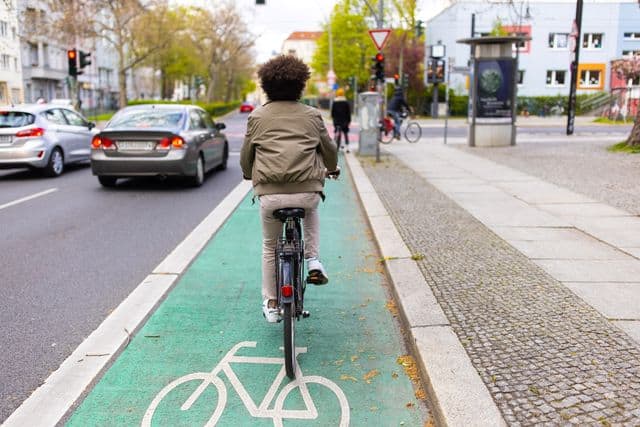What are Indiana’s Bike Laws?
In the heart of the Midwest, Indiana’s cycling community thrives, bringing to the forefront the importance of comprehending Indiana’s bicycle laws to ensure a safe and cooperative environment on the streets. With the cycling community expanding, both cyclists and motorists need clear knowledge of these laws, rights, and responsibilities. Annually, around 700 cyclists die, and approximately 48,000 suffer injuries in vehicle-related accidents in the U.S., highlighting the importance of informed road-sharing. This guide aims to provide a concise yet comprehensive overview of bicycle laws, helping everyone confidently and respectfully share Indiana’s roadways.
Right to the Road
Bicyclists in Indiana are entitled to use the roads just like cars, except on highways where they are not allowed. Although bicycles are not technically classified as vehicles, the law treats cyclists much like drivers of motor vehicles, meaning they must follow the same rules and have the same rights. For example, cyclists are required to ride on the right side of the road, with traffic, and obey all traffic signs and signals.
Right of Way: When operating according to traffic laws, bicyclists have the same rights and responsibilities regarding the right of way as motor vehicle drivers.
Lane Usage and Safety
Indiana’s bicycle laws grant cyclists the right to assert a more central position on the road under specific conditions. When traveling on roads that are too narrow for a bicycle and a motor vehicle to safely share side by side, bicyclists are entitled, and indeed encouraged, to ride in the center of the lane. This practice, known as “taking the lane,” is meant to increase visibility and safety by making the bicyclist more visible to motorists and discouraging unsafe passing. It serves as a clear cue to drivers that they need to give bicycles the full lane’s width when overtaking, as there isn’t enough room to safely share the lane. However, this right comes with the responsibility of keeping a sensible watch for traffic and moving over when it is safe to do so, allowing vehicles to pass when the road widens or when there’s a designated passing area.
Riding Locations for Bicyclists

Bicyclists should use the rightmost lane or stay as close to the right edge of the road as possible when they’re moving slower than traffic.
They can use bicycle lanes when available, although it’s not mandatory.
While riding on sidewalks isn’t banned, local rules may differ, so it’s important to check specific city or town regulations.
Bike riders should ride in pairs side-by-side only unless they’re on bike paths or areas specially designed for bikes.
Signaling
Bicyclists have the right to signal turns using either their arms or mechanical turn signals, just as motor vehicles do. Proper signaling before turning or changing lanes informs other road users of a cyclist’s intentions, greatly enhancing road safety. The law requires that all signals be made in a clear and consistent manner, ensuring they are understandable to motorists, pedestrians, and other cyclists. Using arm signals, cyclists should extend their left arm out horizontally to indicate a left turn and to signal a right turn, extend their left arm out with the elbow bent upwards or extend the right arm out horizontally.
Adherence to Traffic Signals by Bicyclists
Bicyclists must approach stop signs and red traffic lights with caution, coming to a complete halt in both instances. A provision known as the “Dead Red” rule allows cyclists, after stopping at traffic devices signaling red for a minimum of two minutes, to cautiously proceed through the intersection as if the red traffic signal were a stop sign, given they ensure it’s safe to do so before proceeding. This rule acknowledges situations where bicycles may not trigger traffic signal changes, promoting a safer and more practical flow of traffic.
Overtaking Vehicles on the Road
Bicyclists Overtaking Vehicles: On the road, cyclists must pass vehicles cautiously, whether stationary or moving in the same direction. It’s vital for the safety of all road users that cyclists pass with care and attention.
Vehicles Overtaking Bicyclists: Drivers must ensure a minimum clearance of three feet when overtaking bicycles. They should only merge back into the lane when they can do so safely without endangering the cyclist. This rule helps maintain a safe distance between bicycles and motor vehicles, promoting mutual respect and safety on the roads.
Safety Equipment

Safety is paramount when it comes to sharing the road, and equipping bicycles with the necessary safety equipment is a right and a responsibility for all bicyclists. According to Indiana law, bicycles ridden at night must have a front white light visible from a distance of at least 500 feet and a rear red reflector or a light that can be seen from up to 200 feet away. This ensures that bicyclists are visible to motorists in low-light conditions.
Additionally, although not mandated by state law, the use of helmets while riding is strongly encouraged to protect cyclists in case of falls or collisions.
Reflective clothing or accessories can further enhance visibility, especially during dawn, dusk, or at night, contributing significantly to a cyclist’s safety on busy roads. Ensuring that a bicycle is equipped with the right safety gear not only complies with legal requirements but also signals a cyclist’s commitment to safe road-sharing practices.
Motor Vehicle Dooring
Motor vehicle “dooring” is when a cyclist gets hit by a car door opening without checking for bikes. It’s a big danger in cities. While there is no specific law for this incident, the Indiana Driver’s Manual encourages people in cars to look before opening doors in traffic, especially in busy areas shared by bikes and cars. If a dooring happens, the one opening the door is usually at fault.
What to Do After an Accident Involving a Bicycle in Indiana

If you’re involved in an accident with a bicycle in Indiana, protecting your rights and ensuring safety is crucial. Here’s what you should do immediately following the incident:
Check for Injuries: First and foremost, check yourself and others for injuries. If anyone is injured, call 911 immediately to get medical assistance.
Move to a Safe Location: If the accident is minor and there are no severe injuries, move to a safe location away from traffic to prevent further accidents or injuries.
Exchange Information: Exchange contact and insurance information with the other party involved in the accident. This includes names, addresses, phone numbers, driver’s license numbers, and vehicle registration details.
Report the Accident: Report the accident to the police, especially if there are injuries or significant damage. A police report can be an important document for insurance claims and legal proceedings.
Do Not Admit Fault: It’s important to avoid admitting fault at the accident scene. The determination of fault should be left to the police and insurance companies after they have reviewed all the evidence.
Notify Your Insurance Company: Report the accident to your insurance company as soon as possible. Providing them with accurate information and documentation can help with the processing of any claims.
Consult with an Attorney: If there are injuries, significant damages, or if you’re facing legal action, it’s advisable to consult with an attorney who specializes in bicycle accidents in Indiana to understand your rights and options.
Contact Doehrman Buba Ring To Protect Your Rights
If you have been involved in a bicycle accident in Indiana, protecting your rights and seeking legal assistance is vital. Doehrman Buba Ring is a personal injury law firm with extensive experience representing victims of bicycle accidents. Our team of experienced attorneys can help you navigate the complex legal process and secure fair compensation for your injuries and damages. Contact us today for a free consultation. We are here to help you get the justice and compensation you deserve.


